Duo Single Sign-On for Epic Mobile Apps
Last updated:
About Duo Single Sign-On
Duo Single Sign-On is our cloud-hosted SSO product which layers Duo's strong authentication and flexible policy engine on top of Epic Mobile Apps logins using the Security Assertion Markup Language (SAML) 2.0 or OpenID Connect (OIDC) authentication standards. Duo Single Sign-On acts as an OpenID provider (OP), authenticating your users using existing on-premises Active Directory (AD) or any SAML 2.0 IdP and prompting for two-factor authentication before permitting access to Epic Mobile Apps.
Duo Single Sign-On is available in Duo Premier, Duo Advantage, and Duo Essentials plans, which also include the ability to define policies that enforce unique controls for each individual SSO application. For example, you can require that Salesforce users complete two-factor authentication at every login, but only once every seven days when accessing Epic Mobile Apps. Duo checks the user, device, and network against an application's policy before allowing access to the application.
Configure Single Sign-On
Before configuring Epic Mobile Apps with Duo SSO using OpenID Connect (OIDC) authentication you'll first need to configure a working authentication source.
Once you have your SSO authentication source working, continue to the next step of creating the Epic Mobile Apps application in Duo.
When configuring an application to be protected with Duo Single Sign-On you'll need to send attributes from Duo Single Sign-On to the application. Active Directory will work with no additional setup, but if you used a SAML identity provider as your authentication source please verify that you configured it to send the correct SAML attributes.
These default attributes automatically map certain attributes from your authentication source.
| Default Attribute | Active Directory | SAML IdP |
|---|---|---|
<Username> |
sAMAccountName | Username |
<Email Address> |
||
<Display Name> |
displayName | DisplayName |
<First Name> |
givenName | FirstName |
<Last Name> |
sn | LastName |
<AMR> |
Not Applicable | Not Applicable |
AMR will be reported as [`pwd`, `auth-factor-dependent`].
Create the Epic Mobile Apps Application in Duo
-
Log in to the Duo Admin Panel and navigate to Applications → Application Catalog.
-
Locate the entry for Epic Mobile Apps with the "SSO" label in the catalog. Click the + Add button to start configuring Epic Mobile Apps. See Protecting Applications for more information about protecting applications with Duo and additional application options. You'll need the information on the Epic Mobile Apps page under Metadata later.
-
No active Duo users can log in to new applications until you grant access. Update the User access setting to grant access to this application to users in selected Duo groups, or to all users. Learn more about user access to applications. If you do not change this setting now, be sure to update it so that your test user has access before you test your setup.
This setting only applies to users who exist in Duo with "Active" status. This does not affect application access for existing users with "Bypass" status, existing users for whom the effective Authentication Policy for the application specifies "Bypass 2FA" or "Skip MFA", or users who do not exist in Duo when the effective New User Policy for the application allows access to users unknown to Duo without MFA. -
The Metadata section is where you can get OpenID provider information about Duo Single Sign-On to provide to Epic. You'll need information from here later.
Configure Epic Mobile Apps
You'll need to provide some information about Duo Single Sign-On to Epic, like URL information, client id, and client secret. You can find this information in the Metadata section at the top of the application page in the Duo Admin Panel.
Please reach out to your Epic account team for configuration assistance.
Update your Application in Duo
-
Return to the application page in your Duo Admin panel.
-
Navigate to the Relying Party section. You may modify the value of Access Token Lifetime between 5 to 60 minutes. Default is 60 minutes.
-
Optionally, you can configure refresh tokens by checking the box next to Refresh Tokens. You can then modify the following lifetimes:
- Refresh Token Absolute Lifetime: The length of time after an original user authentication that refresh tokens can be exchanged for additional tokens. Once this time has been exceeded, the user will need to authenticate again. The lifetime can be 60 minutes to 180 days. Default is 30 days.
- Refresh Token Inactivity Lifetime: The length of time an individual unused refresh token will be valid before it expires. The lifetime can be 5 minutes to 7 days. Default is 24 hours.
-
Next to Sign-In Redirect URLs we've automatically added the following URLs:
- Haiku:
com.epic.haiku.oidc://callback - Canto:
com.epic.canto.oidc://callback - Rover:
com.epic.rover.oidc://callback
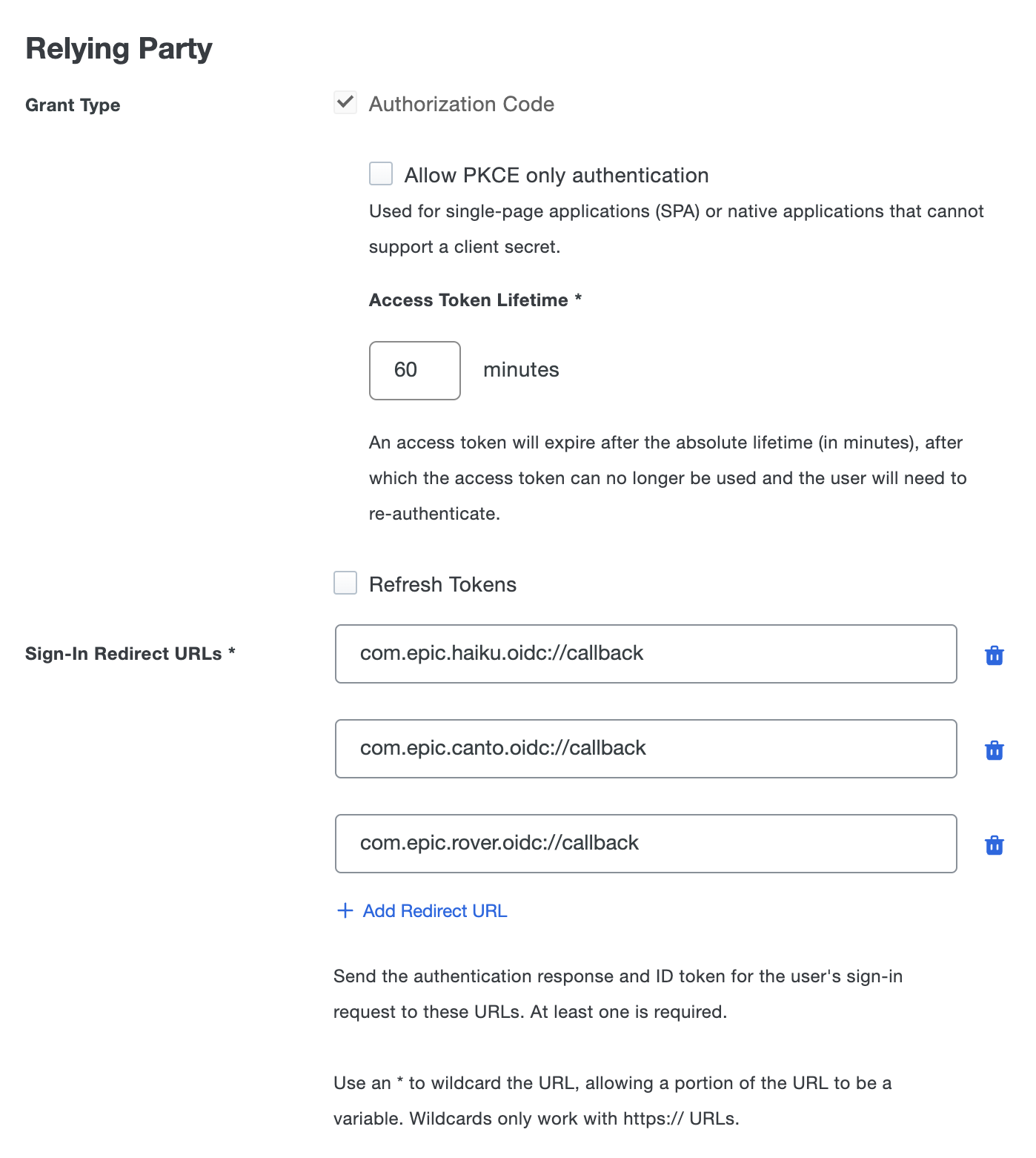
- Haiku:
-
Scopes are used by the Epic during authentication to authorize access to a user's details. Each scope returns a set of user attributes (claims) that are required to be mapped to an IdP attribute. When an OIDC request is sent to Duo SSO only the claims from the requested scopes will be sent back in the response.
We've automatically enabled the following scopes and added the following claims. You will need to fill out which attribute is used from your authsource by adding the IdP Attribute name related to each claim:
- Profile Scope:
-
Claim:
epic_user_id -
Claim:
epic_user_id_type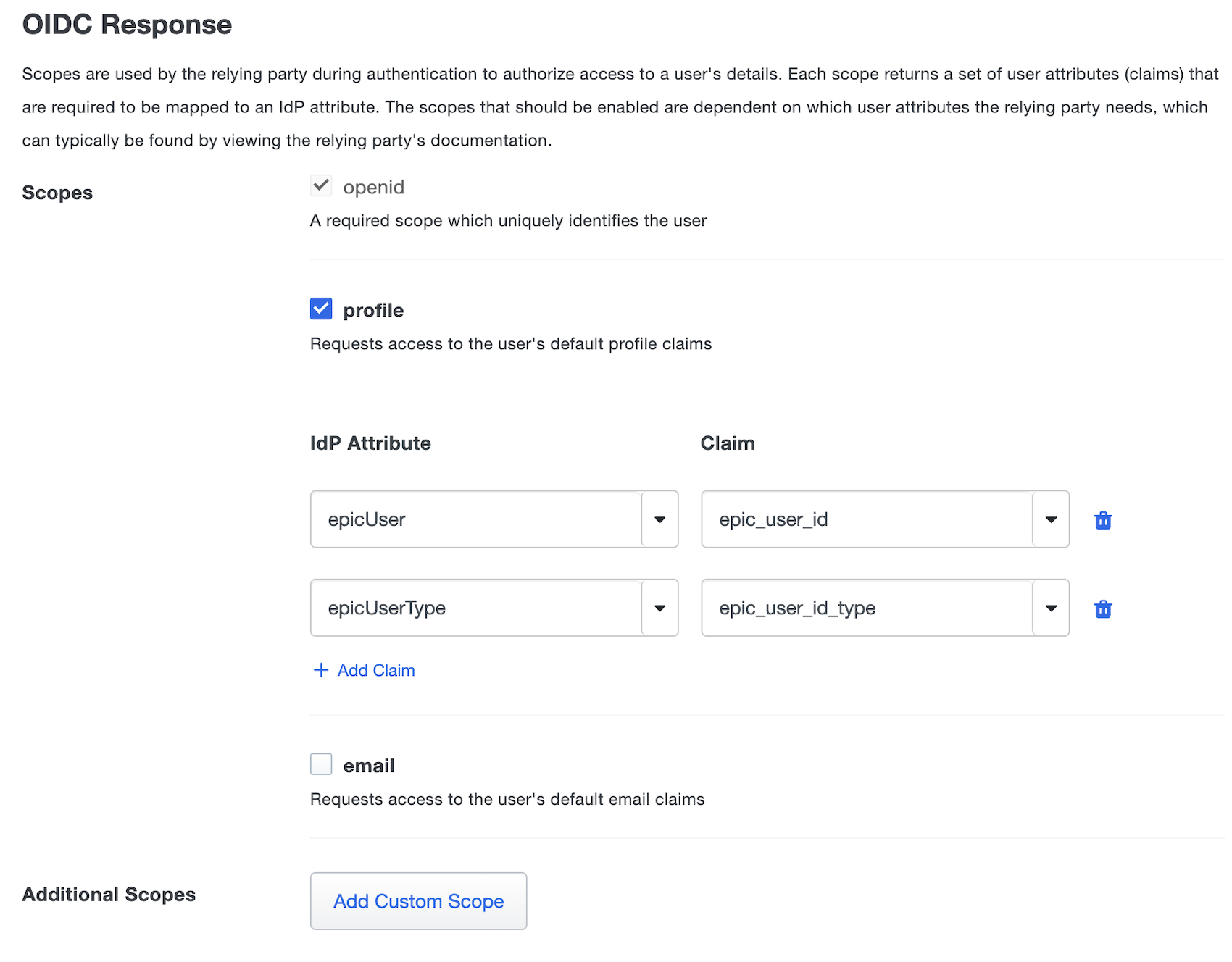
-
- Profile Scope:
-
You can adjust additional settings for your new SSO application at this time — like changing the application's name from the default value, enabling self-service, or assigning a group policy.
-
Scroll down to the bottom of the page and click Save.
Duo Universal Prompt
The Duo Universal Prompt provides a simplified and accessible Duo login experience for web-based applications, offering a redesigned visual interface with security and usability enhancements.
| Universal Prompt | Traditional Prompt |
 |
 |
We've already updated the Duo Epic Mobile Apps application hosted in Duo's service to support the Universal Prompt, so there's no action required on your part to update the application itself. If you created your Epic Mobile Apps application before March 2024, you can activate the Universal Prompt experience for users from the Duo Admin Panel. Epic Mobile Apps applications created after March 2024 have the Universal Prompt activated by default.
If you created your Epic Mobile Apps application before March 2024, it's a good idea to read the Universal Prompt Update Guide for more information, about the update process and the new login experience for users, before you activate the Universal Prompt for your application.
Activate Universal Prompt
Activation of the Universal Prompt is a per-application change. Activating it for one application does not change the login experience for your other Duo applications.
The "Universal Prompt" area of the application details page shows that this application is "Ready to activate", with these activation control options:
- Show traditional prompt: Your users experience Duo's traditional prompt via redirect when logging in to this application.
- Show new Universal Prompt: (Default) Your users experience the Universal Prompt via redirect when logging in to this application.
The application's Universal Prompt status shows "Activation complete" here and on the Universal Prompt Update Progress report.

Should you ever want to roll back to the traditional prompt, you can return to this setting and change it back to Show traditional prompt. However, this will still deliver the Duo prompt via redirect, not in an iframe. Keep in mind that support for the traditional Duo prompt ended for the majority of applications in March 2024.
Universal Update Progress
Click the See Update Progress link to view the Universal Prompt Update Progress report. This report shows the update availability and migration progress for all your Duo applications. You can also activate the new prompt experience for multiple supported applications from the report page instead of visiting the individual details pages for each application.
Verify SSO
Please reach out to your Epic account team for assistance testing your setup.
When you log into an application provided by Duo's Single Sign-On, you will be redirected to Duo Single Sign-On to begin authentication.
Duo-hosted or Active Directory Login
With Duo or Active Directory as the Duo SSO authentication source, enter the primary username (email address) on the Duo SSO login page and click or tap Next.
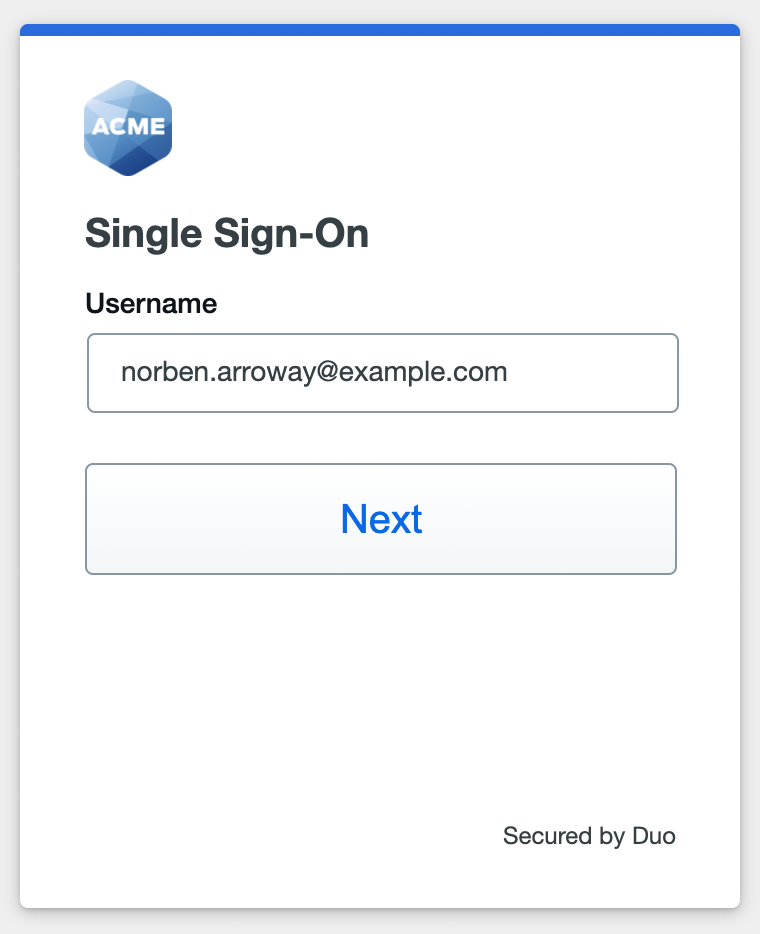
Enter the Duo or AD primary password and click or tap Log in to continue.
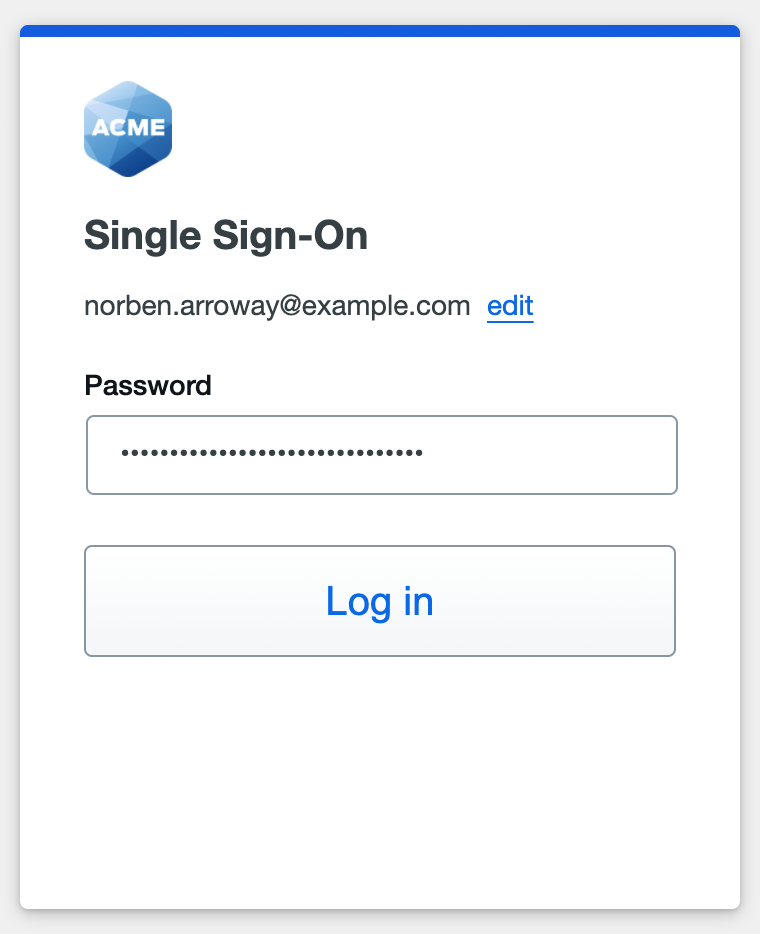
When using Duo Passwordless you won't need to enter a password, and will proceed directly to Duo authentication.
SAML Login
With a SAML identity provider as the Duo SSO authentication source, Duo SSO immediately redirects the login attempt to that SAML IdP for primary authentication. Users do not see the Duo SSO primary login screen.
Duo Authentication
Successful verification of your primary credentials by Duo, Active Directory or a SAML IdP redirects back to Duo. Complete Duo two-factor authentication when prompted and then get redirected back to the Epic Mobile app to complete the login process.
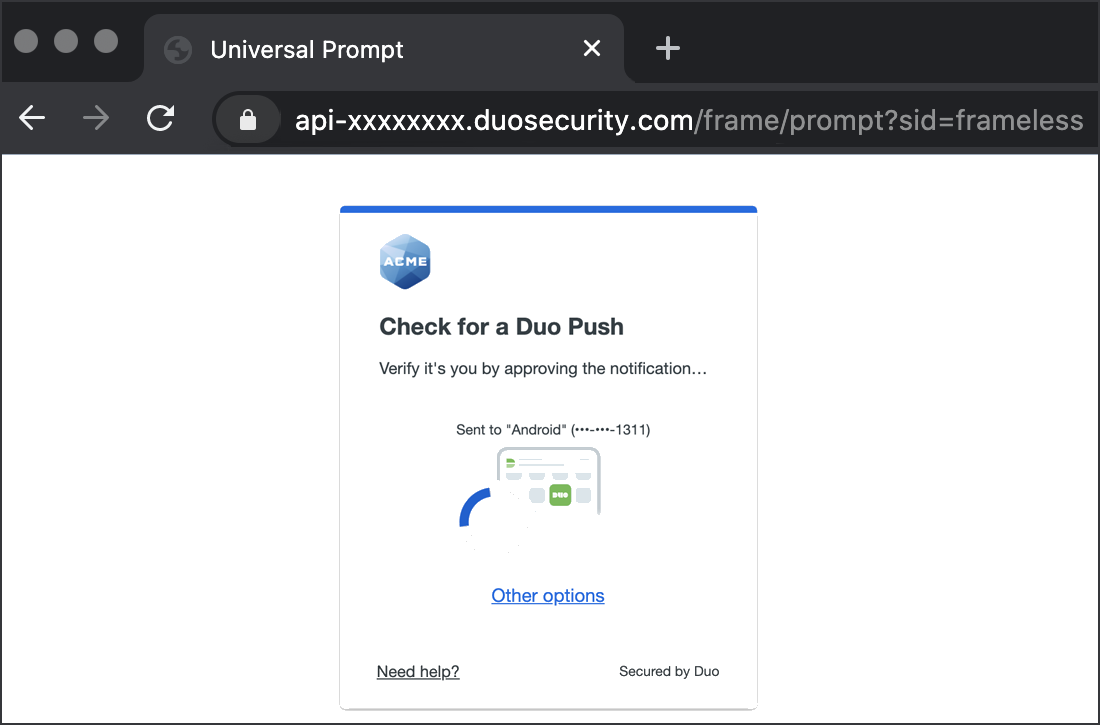
*Universal Prompt experience shown.
Grant Access to Users
If you did not already grant user access to the Duo users you want to use this application be sure to do that before inviting or requiring them to log in with Duo.
Automated Provisioning
You may be able to create, manage, and delete users and groups in this application automatically from Duo using SCIM 2.0 provisioning. See Automated Provisioning to learn how.
Troubleshooting
Need some help? Try searching our Knowledge Base articles or Community discussions. For further assistance, contact Support.
